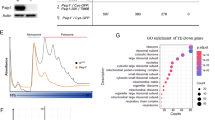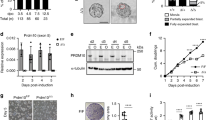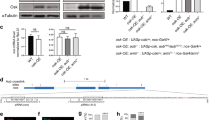Abstract
Signalling by the TGF-β superfamily member and BMP orthologue Decapentaplegic (Dpp) is crucial for multiple developmental programmes and has to be tightly regulated. Here, we demonstrate that the Drosophila Dpp pathway is negatively regulated by eukaryotic translation initiation factor 4A (eIF4A), which mediates activation-dependent degradation of the Dpp signalling components Mad and Medea. eIF4A mutants exhibit increased Dpp signalling and accumulation of Mad and phospho-Mad. Overexpression of eIF4A decreases Dpp signalling and causes loss of Mad and phospho-Mad. Furthermore, eIF4A physically associates with Mad and Medea, and promotes their degradation following activation of Dpp signalling in a translation-independent manner. Finally, we show that eIF4A acts synergistically with, but independently of, the ubiquitin ligase DSmurf, indicating that a dual system controls SMAD degradation. Thus, in addition to being an obligatory component of the cap-dependent translation initiation complex, eIF4A has a novel function as a specific inhibitor of Dpp signalling that mediates the degradation of SMAD homologues.
This is a preview of subscription content, access via your institution
Access options
Subscribe to this journal
Receive 12 print issues and online access
$209.00 per year
only $17.42 per issue
Buy this article
- Purchase on Springer Link
- Instant access to full article PDF
Prices may be subject to local taxes which are calculated during checkout




Similar content being viewed by others
References
Li, J., Li, W. X. & Gelbart, W. M. A genetic screen for maternal-effect suppressors of decapentaplegic identifies the eukaryotic translation initiation factor 4A in Drosophila. Genetics 171, 1629–1641 (2006).
Wharton, K. A., Ray, R. P. & Gelbart, W. M. An activity gradient of decapentaplegic is necessary for the specification of dorsal pattern elements in the Drosophila embryo. Development 117, 807–822 (1993).
Galloni, M. & Edgar, B. A. Cell-autonomous and non-autonomous growth-defective mutants of Drosophila melanogaster. Development 126, 2365–2375 (1999).
Newfeld, S. J. et al. Mothers against dpp participates in a DDP/TGF-β responsive serine-threonine kinase signal transduction cascade. Development 124, 3167–3176 (1997).
Sekelsky, J. J., Newfeld, S. J., Raftery, L. A., Chartoff, E. H. & Gelbart, W. M. Genetic characterization and cloning of mothers against dpp, a gene required for decapentaplegic function in Drosophila melanogaster. Genetics 139, 1347–1358 (1995).
Brummel, T. J. et al. Characterization and relationship of Dpp receptors encoded by the saxophone and thick veins genes in Drosophila. Cell 78, 251–261 (1994).
Penton, A. et al. Identification of two bone morphogenetic protein type I receptors in Drosophila and evidence that Brk25D is a decapentaplegic receptor. Cell 78, 239–250 (1994).
Xie, T., Finelli, A. L. & Padgett, R. W. The Drosophila saxophone gene: a serine-threonine kinase receptor of the TGF-β superfamily. Science 263, 1756–1759 (1994).
Nellen, D., Affolter, M. & Basler, K. Receptor serine/threonine kinases implicated in the control of Drosophila body pattern by decapentaplegic. Cell 78, 225–237 (1994).
Dorfman, R. & Shilo, B. Z. Biphasic activation of the BMP pathway patterns the Drosophila embryonic dorsal region. Development 128, 965–972 (2001).
Podos, S. D., Hanson, K. K., Wang, Y. C. & Ferguson, E. L. The DSmurf ubiquitin-protein ligase restricts BMP signaling spatially and temporally during Drosophila embryogenesis. Dev. Cell 1, 567–578 (2001).
Brand, A. H. & Perrimon, N. Targeted gene expression as a means of altering cell fates and generating dominant phenotypes. Development 118, 401–415 (1993).
Nellen, D., Burke, R., Struhl, G. & Basler, K. Direct and long-range action of a DPP morphogen gradient. Cell 85, 357–368 (1996).
Hudson, J. B., Podos, S. D., Keith, K., Simpson, S. L. & Ferguson, E. L. The Drosophila Medea gene is required downstream of dpp and encodes a functional homolog of human Smad4. Development 125, 1407–1420 (1998).
Wisotzkey, R. G. et al. Medea is a Drosophila Smad4 homolog that is differentially required to potentiate DPP responses. Development 125, 1433–1445 (1998).
Liang, Y. Y. et al. dSmurf selectively degrades decapentaplegic-activated MAD, and its overexpression disrupts imaginal disc development. J. Biol. Chem. 278, 26307–26310 (2003).
Lachance, P. E., Miron, M., Raught, B., Sonenberg, N. & Lasko, P. Phosphorylation of eukaryotic translation initiation factor 4E is critical for growth. Mol. Cell. Biol. 22, 1656–1663 (2002).
Haerry, T. E., Khalsa, O., O'Connor, M. B. & Wharton, K. A. Synergistic signaling by two BMP ligands through the SAX and TKV receptors controls wing growth and patterning in Drosophila. Development 125, 3977–3987 (1998).
Gustafson, K. & Boulianne, G. L. Distinct expression patterns detected within individual tissues by the GAL4 enhancer trap technique. Genome 39, 174–182 (1996).
Inoue, H. et al. Interplay of signal mediators of decapentaplegic (Dpp): molecular characterization of mothers against dpp, Medea, and daughters against dpp. Mol. Biol. Cell 9, 2145–2156 (1998).
Acknowledgements
We thank S. Matics for technical assistance, M. Kawabata, P. Lasko, P. ten Dijke, C. Proud, W. Gelbart, D. Bohmann, Y. Sun, J. Zhao, J. Jiang, C. Proschel, and the Bloomington Drosophila Stock Center for various reagents and Drosophila strains. We thank Y. Sun for insightful discussions regarding possible mechanisms of eIF4A involvement in Dpp signalling and comments on the manuscript. J.L. was a recipient of the Wilmot Cancer Research Fellowship from the James P. Wilmot Foundation. This study was supported, in part, by grants from the National Institutes of Health (R01GM65774; R01GM077046) and an American Cancer Society Research Scholar Grant (RSG-06-196-01-TBE) to W.X.L.
Author information
Authors and Affiliations
Contributions
J.L. coplanned the project, performed experiments and analysed data. W.X.L. planned the project and wrote the paper.
Corresponding author
Ethics declarations
Competing interests
The authors declare no competing financial interests.
Supplementary information
Supplementary Information
Supplementary Figures S1, S2, S3, S4 and S5 (PDF 880 kb)
Rights and permissions
About this article
Cite this article
Li, J., Li, W. A novel function of Drosophila eIF4A as a negative regulator of Dpp/BMP signalling that mediates SMAD degradation. Nat Cell Biol 8, 1407–1414 (2006). https://doi.org/10.1038/ncb1506
Received:
Accepted:
Published:
Issue Date:
DOI: https://doi.org/10.1038/ncb1506
This article is cited by
-
The integrated stress response regulates BMP signalling through effects on translation
BMC Biology (2018)
-
Comparative proteomics reveals the physiological differences between winter tender shoots and spring tender shoots of a novel tea (Camellia sinensis L.) cultivar evergrowing in winter
BMC Plant Biology (2017)
-
A eukaryotic initiation factor 5C is upregulated during metamorphosis in the cotton bollworm, Helicoverpa armigera
BMC Developmental Biology (2009)
-
Lysine Conservation and Context in TGFβ and Wnt Signaling Suggest New Targets and General Themes for Posttranslational Modification
Journal of Molecular Evolution (2008)
-
eIF4A goes beyond translation
Nature Cell Biology (2006)



